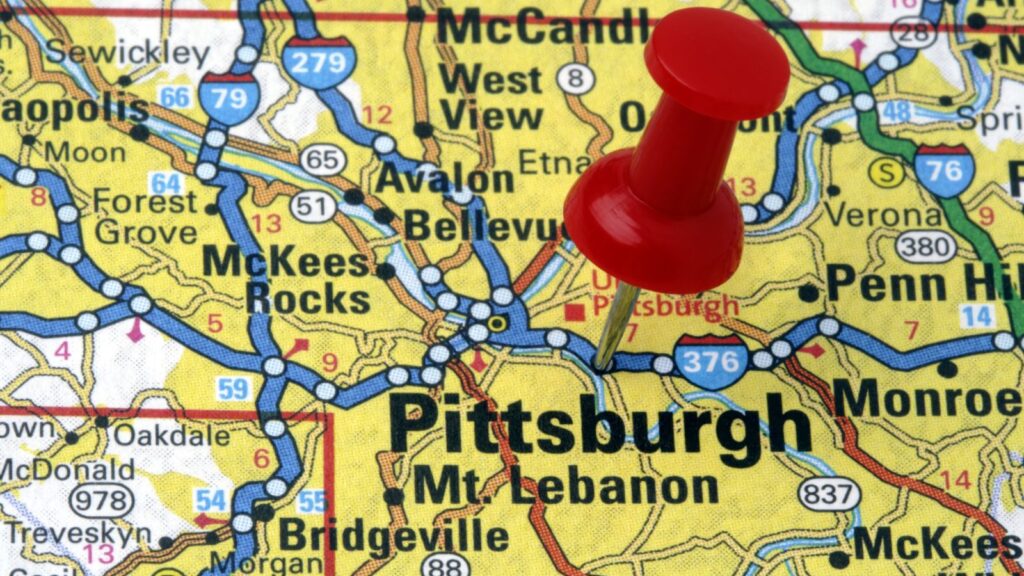Nestled at the confluence of three rivers, Pittsburgh is a city rich in history and culture, making its map a fascinating tapestry of neighborhoods and landmarks. Known as the “Steel City” for its industrial roots, Pittsburgh has evolved into a dynamic metropolis with a unique blend of old-world charm and modern innovation. As one of the most affordable cities to visit, Pittsburgh frequently ranks high among cheap US destinations. It offers travelers a budget-friendly experience without sacrificing its vibrant arts scene, culinary delights, and rich historical sites, making it a perfect choice for an economical yet fulfilling getaway.
Map:Mri7wrjajx0= Pittsburgh
 A Pittsburgh map provides a comprehensive view of the city’s layout, highlighting its intricate network of roads and bridges. With three rivers—the Allegheny, Monongahela, and Ohio—intersecting the city, navigation can be complex. The map aids in understanding Pittsburgh’s geography, showcasing major highways like I-376 and I-279 which connect different parts of the city.
A Pittsburgh map provides a comprehensive view of the city’s layout, highlighting its intricate network of roads and bridges. With three rivers—the Allegheny, Monongahela, and Ohio—intersecting the city, navigation can be complex. The map aids in understanding Pittsburgh’s geography, showcasing major highways like I-376 and I-279 which connect different parts of the city.
The map identifies key landmarks such as Point State Park, offering a starting point for exploration. Downtown Pittsburgh, the cultural and business hub, is easily navigated with a detailed street map. Additionally, the map highlights the city’s 90 neighborhoods (e.g., Squirrel Hill, Shadyside) known for their distinct character and attractions.
Tourist attractions, including the Carnegie Museums, Phipps Conservatory, and the Pittsburgh Zoo, are marked on the map, making it easier for visitors to plan itineraries. Parks like Schenley and Frick provide green spaces outlined on the map for recreational activities. This comprehensive view supports efficient travel and enriched experiences within Pittsburgh.
Key Features Of Modern Pittsburgh Maps
Modern Pittsburgh maps integrate advanced technologies to offer detailed insights into the city’s expansive and diverse features.
Transportation And Infrastructure
 Pittsburgh maps highlight the city’s comprehensive transportation network. Key transit routes such as I-376 and I-279 are clearly marked, facilitating efficient commuting across regions. The inclusion of public transit lines, like buses and light rail systems, enables residents and visitors to navigate urban and suburban areas seamlessly. Major bridges, critical for crossing the Allegheny, Monongahela, and Ohio rivers, are prominently displayed. Pittsburgh International Airport and local stations add connectivity, ensuring easy access to and within the city. Interactive map platforms often offer real-time traffic updates and alternate route suggestions, enhancing travel planning.
Pittsburgh maps highlight the city’s comprehensive transportation network. Key transit routes such as I-376 and I-279 are clearly marked, facilitating efficient commuting across regions. The inclusion of public transit lines, like buses and light rail systems, enables residents and visitors to navigate urban and suburban areas seamlessly. Major bridges, critical for crossing the Allegheny, Monongahela, and Ohio rivers, are prominently displayed. Pittsburgh International Airport and local stations add connectivity, ensuring easy access to and within the city. Interactive map platforms often offer real-time traffic updates and alternate route suggestions, enhancing travel planning.
Cultural And Tourist Attractions
Diverse cultural and tourist hotspots feature prominently on Pittsburgh maps. Iconic sites like the Carnegie Museums, Phipps Conservatory, and the Pittsburgh Zoo draw in tourists, offering rich educational experiences. Historical neighborhoods like the South Side and the Strip District boast numerous dining and entertainment options. Maps often highlight parks such as Schenley and Frick, ideal for recreational activities. Additionally, the maps indicate venues for cultural festivals and events, ensuring users don’t miss unique local experiences. Detailed depictions of these locations serve both locals and tourists, providing clear pathways to explore Pittsburgh’s rich heritage and vibrant city life.
How To Choose The Best Pittsburgh Map
Choosing the ideal Pittsburgh map involves considering several key factors based on the intended use and specific requirements.
-
Purpose: Determine if the map is for navigation, exploration, or educational purposes. Navigation maps should include detailed road layouts, transit routes, and real-time traffic data. Exploration maps might focus on tourist attractions, parks, and cultural landmarks. Educational maps could emphasize historical or geographic details.
-
Type: Select between physical and digital formats. Physical maps offer a tangible overview ideal for those preferring traditional navigation. Digital maps provide interactive features, GPS integration, and updates. Services like Google Maps offer real-time navigation and location-based information, catering to tech-savvy users seeking convenience.
-
Detail: Assess the level of detail needed. Comprehensive maps should depict major highways like I-376 and I-279, significant bridges, neighborhoods, and landmarks. For visitors, maps highlighting attractions such as Carnegie Museums or Phipps Conservatory are beneficial.
-
Usability: Consider the ease of use. Physical maps should be clearly legible with a user-friendly design. Digital maps must have intuitive interfaces and quick-response features for effective navigation.
-
Updates: Choose maps with the latest data. Opt for digital maps offering regular updates on road conditions, new infrastructure, and altered routes. Updated maps ensure reliable guidance through Pittsburgh’s changing cityscape.
A Comprehensive View
Understanding Pittsburgh through its maps offers invaluable insights into the city’s dynamic landscape and rich cultural tapestry. Whether navigating its historic neighborhoods or exploring its modern attractions, a well-chosen map enhances the experience by providing clarity and direction.

